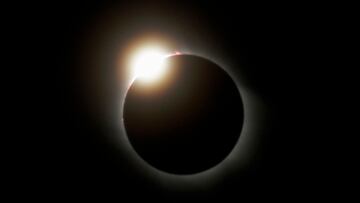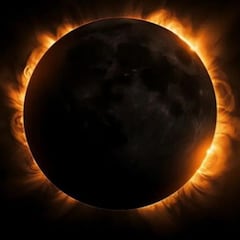How do flat-earthers explain a total solar eclipse?
Believers in the utterly disproven theory of a flat-earth are claiming the upcoming total solar eclipse in the United States helps explain their ideas. Here’s what the say. And why it’s wrong.

Millions of Americans will have a chance to see a total solar eclipse on Monday 8 April. The path of totality, where the sun is completely blotted out, will sweep across the nation from Texas to New England.
This is the second time in seven years that the Moon’s shadow will traverse the US but the rare and magnificent celestial event won’t happen again over the US until 2044. This time round it is expected to be even more spectacular than the 2017 total solar eclipse. But like last time the spectacle will provide fodder to fuel the ridiculous and disproven theory that the Earth is flat. Even though it’s simple to prove them wrong, as people have been doing since the ancient Greeks.
How do flat-earthers explain a total solar eclipse?
Flat-earthers, as the name suggests, believe that we live on a disk. The center of the hockey puck-like Earth is the North Pole and at the edge is a giant ice wall. Rising up from the ice wall is a glass dome, called the firmament, inside of which the Sun, Moon and stars move while the Earth remains stationary.
Prior to the last total solar eclipse MIC spoke with a handful of proponents of the flat-earth theory. They shared why a solar eclipse gives irrefutable proof that the Earth is not a sphere.
Research #flatearth pic.twitter.com/dkokXcj3BX
— Flat Earth Zone (@FlatEarthZone) June 27, 2023
One of the arguments that the solar eclipse gives to prove the Earth is flat is that the Moon’s shadow moves across the Earth’s surface from west to east. That is the opposite direction that our closest heavenly neighbor and our star move through the sky which proves that it is the Sun that is moving and not the Earth rotating.
Secondly, the size of the shadow cast backs up the idea that the Earth is flat in another way. The theory goes that it is too small to be explained by a spherical planet, that homemade experiments show that a shadow will always be as big, or bigger, as the object which is creating it.
Additionally, the Earth and the Moon, according to some flat-earth theories, are the same size. So, some argue that were the earth a sphere, and it was orbiting the Sun, the shadow cast would cover the entire planet.
Get ready for the April 8th solar eclipse by familiarizing yourself with the two parts of the Moon's shadow: The umbra and penumbra! 🌑
— OpenSpace (@OpenSpaceProj) April 1, 2024
Video created in OpenSpace. Images: NASA's Scientific Visualization Studio, NASA/Luc Viatour, NASA/Bill Ingalls#NASA #space #eclipse2024 pic.twitter.com/473D0STxBd
Simple explanations debunk the flat-earth theory about solar eclipses
Unfortunately, none of these arguments take into the mechanics of how the Earth, Sun and Moon interact in their celestial dance. Nor are the tools used to conduct experiments at homes appropriate for getting the right conditions.
Related stories
According to NASA, the Earth rotates at roughly 1,670 kilometers per hour at the equator. But the Moon is going over twice as fast in its orbit trucking along at about 3,400 kilometers per hour. So even though the Moon is moving in the same direction as the Earth rotates, its shadow will move across the surface much faster than the Sun in the sky.
As for the size of the shadow, homemade experiments are generally carried out with a concentrated light source like a flashlight or lamp that project a concentrated beam. That is unlike the Sun which emits light in all directions. Nor do they take in the relative size of the two bodies and the distance between them in space. However, with the correct setup, those that want to recreate a solar eclipse effect on an orbe, can do so.



Complete your personal details to comment